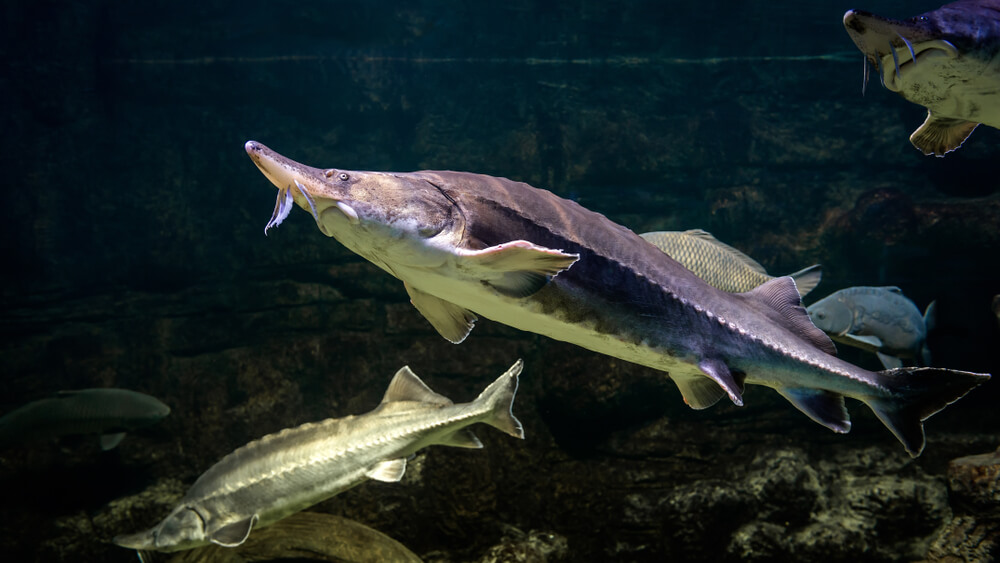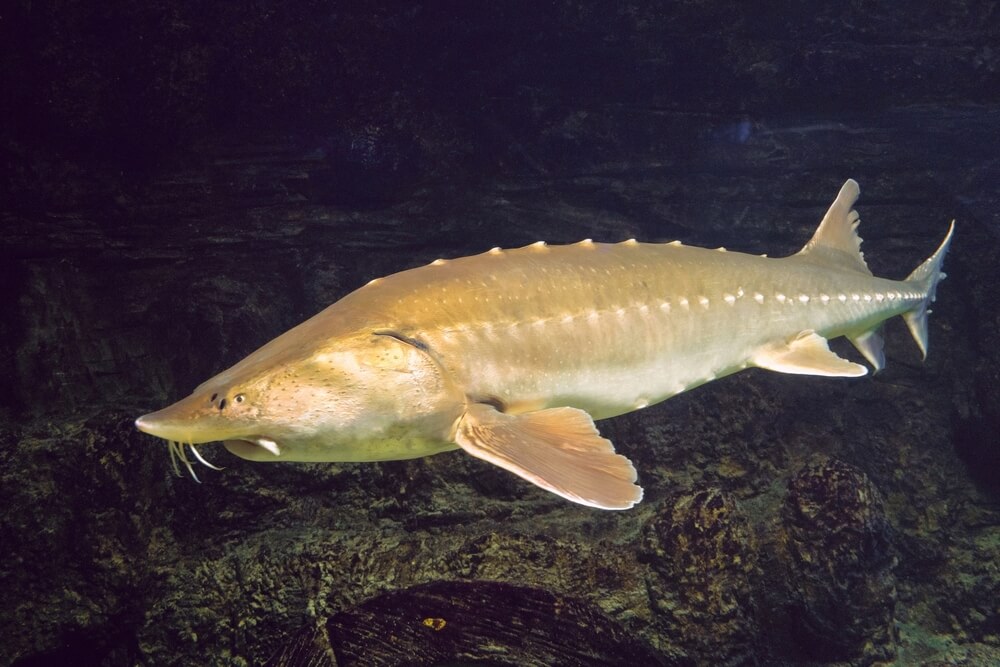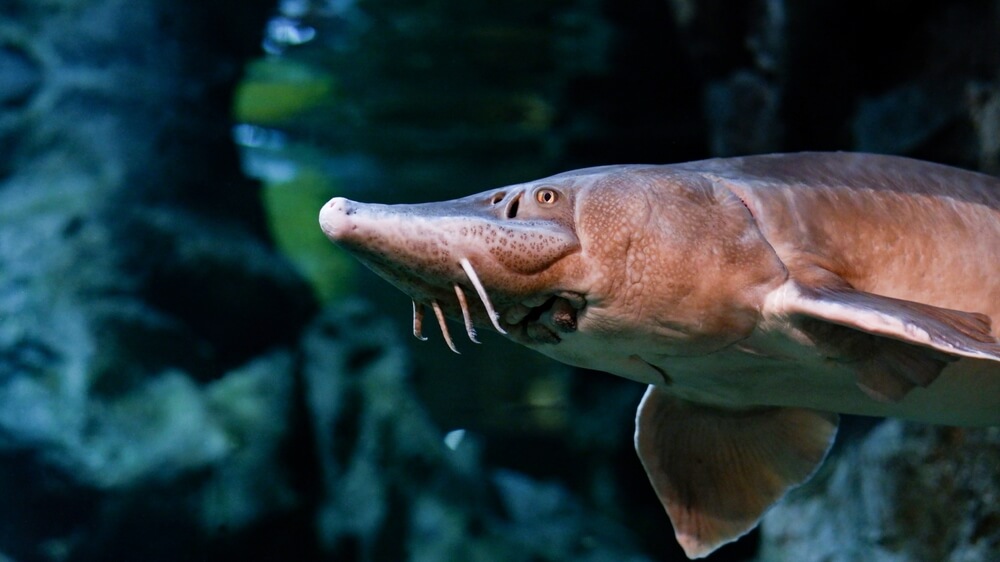Kaluga Sturgeon: Habitat and Characteristics

The Kaluga sturgeon – a fish that’s a member of the Acipenseridae family – may not have a very friendly face, but it holds great mysteries that make it entirely worthy of study. Unfortunately, this species is in serious danger of extinction, as the adult specimens are exploited to obtain black caviar.
This sturgeon is the only one of its genus, along with the beluga (Huso huso), and is endemic to its geographical area. It’s a fish that weighs many pounds and lives for many years -as much as one hundred- and here, you can learn more about it. Keep reading!
Meet the Kaluga sturgeon
The Kaluga Sturgeon’s habitat
The Kaluga sturgeon (Huso Mauritius) can only be found in the Amur River, which runs along the border between Russia and China, as well as its main tributaries and some small lakes in its basin, such as the Nikolaevsk and the Orel. When out in the open sea, this fish can be found in the Sea of Okhotsk and sometimes the Sea of Japan.
The physical characteristics of the Kaluga sturgeon
The Kaluga sturgeon is considered the largest freshwater fish in the world, as it can reach some 19.5 feet in length and almost one ton in weight. Its fusiform body is reinforced with five rows of hardened scales, one being dorsal, two being lateral, and two being ventral.
Its body is grayish green in the dorsal area, lightening to greenish white in the belly area.
In addition, this animal has a large mouth, which in turn contains certain structures that can move outward. This characteristic helps it to capture its prey, as it’s a carnivore. On the outside of the snout, it has four flattened barbs, which perform an invaluable sensory function in turbid waters where vision is of little use.

The behavior of the Kaluga sturgeon
The Kaluga sturgeon is a solitary and predatory fish. It’s a species that doesn’t exhibit parental care, so the young are self-sufficient from the time they hatch from the egg.
These fish prefer clear water with a light-colored bottom, especially during their seaward journey. This preference allows them to swim close to the surface of the river, where the young can better avoid predators.
The diet of the Kaluga sturgeon
This fish is a hunter, although it doesn’t have much preference in terms of species. In other words, if it fits in its mouth, the Kaluga sturgeon will eat it. In fact, it even engages in cannibalism if food is scarce. Its most common prey are pike, carp, herring, salmon, and salmon keta. As soon as they’re born, the young feed on smaller creatures such as zooplankton, insects, and shrimp.
Kaluga reproduction
The reproductive cycle begins with spawning, which takes place from May to July. During this period, sturgeons return to the Amur River to deposit their eggs in shallow areas with strong currents. The young remain in the egg for 83 to 295 hours and hatch with a yolk sac, which nourishes them for up to eight to nine days of life.
Although they reproduce up to five times during the spawning period, females can only reproduce every four years.
The migration of the hatchlings to the sea is considered passive, as they’re dragged by the current. Once they reach open water, they remain there until they reach reproductive maturity, between ten and fourteen years of age.
Conservation status
The Kaluga sturgeon, which is critically endangered, faces a multifaceted threat. The primary cause behind its alarming decline since the 19th century lies in extensive fishing within its habitat, primarily driven by the demand for caviar. Climate change adds another layer of complexity, as fluctuating water temperatures disrupt the reproductive cycles of female Kaluga sturgeons.
Human land use near the Amur River amplifies the challenges. Discharges from construction and logging activities impact the river ecosystem, further jeopardizing the Kaluga sturgeon. The introduction of invasive species exacerbates the difficulty of conserving their habitat, creating a precarious environment for these majestic creatures.
Late sexual maturation compounds the species’ struggle for survival. Adult specimens, susceptible to capture for over a decade, remain unable to reproduce until at least six years of age. This significant hurdle hampers the recovery of the Kaluga sturgeon population.
Despite bans on fishing along the river imposed by government agencies in China and Russia, poaching persists. Even with sturgeon fish farms catering to caviar production, the species continues its decline. The critical situation underscores the urgent need for comprehensive conservation efforts to safeguard the Kaluga sturgeon from extinction.
“We have already done a lot of irreparable damage to our co-inhabitants, but there must be some point for us to start doubting our omnipotence. We have to exercise our moral responsibility and not deprive sturgeon, the magical and mysterious ‘dinosaur fish,” of their ‘unimpeachable right to continued existence.’”
– Natalia M. Restivo –

In conclusion, the Kaluga sturgeon, a creature of both mystery and magnificence, finds itself at the crossroads of perilous endangerment. Despite its unfriendly facade, this remarkable species is on the brink of extinction, driven by the relentless pursuit of its adult specimens for coveted black caviar.
It’s sad to read again and again that the main causes of the extinction of any species come from human beings. Although different organizations constantly strive to protect living beings, providing information to the general public about any endangered species is essential. In other words, learning about the consequences of our own carelessness opens the doors of awareness about the need to protect the planet.
“When it comes to looking after all the species that are already endangered, there’s such a lot to do that sometimes it might all seem to be too much, especially when there are so many other important things to worry about. But if we stop trying, the chances are that pretty soon we’ll end up with a world where there are no tigers or elephants, or sawfishes or whooping cranes, or albatrosses or ground iguanas. And I think that would be a shame, don’t you?”
– Martin Jenkins –
All cited sources were thoroughly reviewed by our team to ensure their quality, reliability, currency, and validity. The bibliography of this article was considered reliable and of academic or scientific accuracy.
- Ruban, G. y Qiwei, W. 2010. Huso dauricus . La Lista Roja de Especies Amenazadas de la UICN 2010: e.T10268A3186676. https://dx.doi.org/10.2305/IUCN.UK.2010-1.RLTS.T10268A3186676.en . Descargado el 17 de junio de 2021
- Huso dauricus. (2021). NaturaLista.co. https://colombia.inaturalist.org/taxa/102974-Huso-dauricus
- Familia Acipenseridae – 125 – Biodiversidad Virtual / Peces. (2021). Biodiversidad Virtual Peces. https://www.biodiversidadvirtual.org/peces/Familia-Acipenseridae-cat125.html
